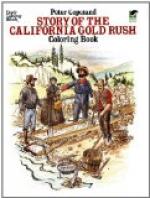San Antonio, a very successful Mission, was the third one established, and it was in a beautiful little valley of the Santa Lucia Mountains. Every kind of fruit grew in its orchards, and the Indians there were very happy and contented, and in large workshops made cloth, saddles, and other things. San Gabriel, not far from Los Angeles and sometimes called the finest church of all, was the next to be built. This was the richest of the Missions and had great stores of wool, wheat, and fruit, which the hard-working Indians earned and gave to the church. The Indians, indeed, were almost slaves, and worked all their lives for the Padres without rest or pay. At San Gabriel the first California flour-mill worked by a stream of water turning the wheel, was put up. Some of the old palms and olive trees are still growing there.
San Juan Capistrano, founded in 1776, was one of the best-known Missions, for it had a seaport of its own at San Juan. Vessels came to its port for the hides and tallow of thousands of cattle herded round the Mission. The first fine church of this Mission was destroyed by an earthquake, and many people were killed by its falling roof. It was rebuilt, however, and still shows its fine front, and long corridors or porches round a hollow square where a garden and fountain used to be.
Old records tell us that Father Serra felt that there should be a church named in honor of Francis, who was the founder and patron saint of the Franciscan brotherhood of monks to which these missionaries belonged. When Father Serra spoke of this to Galvez, that priest replied, “If our good Saint Francis wants a Mission, let him show us that fine harbor up above Monterey and we will build him one there.” Several explorers had failed to find this port about which Indians had spoken to the Spanish. At last Ortega discovered it, and Father Palou, in 1776, consecrated the Mission of San Francisco. Near the spot was a small lake called the “Laguna de los Dolores,” and from this the church was at last known as the Mission Dolores. But the great city bears the Spanish name of Saint Francis, or San Francisco. A fort was erected where the present Presidio stands, and later a battery of cannon was placed at Black Point. It is told that the Indians were very quarrelsome here and fought so among themselves that the Padres could get no church built for a year. In that part of San Francisco called the Mission, the old building with its odd roof and three of the ancient bells is a very interesting place to visit. There are pictures, and other relics of the past to see, and in the graveyard many of San Francisco’s early settlers were buried. This was the sixth Mission of Alta California.
The Santa Barbara Mission, where Franciscan fathers still live, has a fine church with double towers and a long row of two-story adobe buildings enclosing a hollow square where a beautiful garden is kept. One of the brotherhood, wearing a long brown robe just as Father Serra did, takes visitors into the church, and also shows them the garden and a large carved stone fountain. This church is built of sandstone with two large towers and a chime of six bells, and was finished in 1820.




